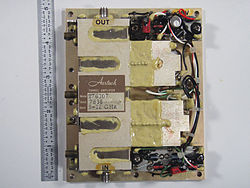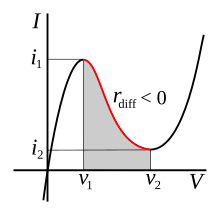Tunnel diode
 1N3716 tunnel diode (with 0.1 "jumperfor scale) | |
| Type | Passive |
|---|---|
| Working principle | Quantum tunneling |
| Invented | Leo Esaki Yuriko Kurose[1] |
| First production | Sony |
| Pin configuration | anodeandcathode |
| Electronic symbol | |
 | |

Atunnel diodeorEsaki diodeis a type ofsemiconductor diodethat has effectively "negative resistance"due to thequantum mechanicaleffect calledtunneling.It was invented in August 1957 byLeo Esakiand Yuriko Kurose when working at Tokyo Tsushin Kogyo, now known asSony.[1][2][3][4]In 1973, Esaki received theNobel Prize in Physicsfor experimental demonstration of theelectron tunnelingeffect in semiconductors.[5]Robert Noyceindependently devised the idea of a tunnel diode while working forWilliam Shockley,but was discouraged from pursuing it.[6]Tunnel diodes were first manufactured by Sony in 1957,[7]followed byGeneral Electricand other companies from about 1960, and are still made in low volume today.[8]
Tunnel diodes have a heavilydopedpositive-to-negative (P-N) junctionthat is about 10 nm (100Å) wide. The heavy doping results in a brokenband gap,whereconduction bandelectron stateson the N-side are more or less aligned withvalence bandhole stateson the P-side. They are usually made fromgermanium,but can also be made fromgallium arsenide,gallium antimonide (GaSb) andsiliconmaterials.
Uses
[edit]Thenegative differential resistancein part of their operating range allows them to function asoscillatorsandamplifiers,and inswitching circuitsusinghysteresis.They are also used asfrequency convertersanddetectors.[9]: 7–35 Their lowcapacitanceallows them to function atmicrowavefrequencies, far above the range of ordinary diodes andtransistors.

Due to their low output power, tunnel diodes are not widely used: Theirradio frequencyoutput is limited to a few hundred milliwatts due to their small voltage swing. In recent years, however, new devices that use the tunneling mechanism have been developed. Theresonant-tunneling diode(RTD) has achieved some of the highest frequencies of anysolid-stateoscillator.[10]
Another type of tunnel diode is ametal-insulator-insulator-metal(MIIM) diode, where an additional insulator layer allows "step tunneling"for more precise control of the diode.[11]There is also ametal-insulator-metal(MIM) diode, but due to inherent sensitivities, its present application appears to be limited to research environments.[12]
Forward bias operation
[edit]Under normalforward biasoperation, asvoltagebegins to increase,electronsat first tunnel through the very narrow P-N junction barrier and fill electron states in the conduction band on the N-side which become aligned with empty valence band hole states on the P-side of the P-N junction. As voltage increases further, these states become increasingly misaligned, and the current drops. This is callednegative differential resistancebecause currentdecreaseswithincreasingvoltage. As voltage increases beyond a fixed transition point, the diode begins to operate as a normal diode, where electrons travel by conduction across the P-N junction, and no longer by tunneling through the P–N junction barrier. The most important operating region for a tunnel diode is the "negative resistance" region. Its graph is different from normal P-N junction diode.
Reverse bias operation
[edit]
When used in the reverse direction, tunnel diodes are calledback diodes(orbackward diodes) and can act as fastrectifierswith zero offset voltage and extreme linearity for power signals (they have an accuratesquare lawcharacteristic in the reverse direction). Underreverse bias,filled states on the P-side become increasingly aligned with empty states on the N-side, and electrons now tunnel through the P-N junction barrier in reverse direction.
Technical comparisons
[edit]
In a conventional semiconductor diode, conduction takes place while the P-N junction is forward biased and blocks current flow when the junction is reverse biased. This occurs up to a point known as the "reverse breakdown voltage" at which point conduction begins (often accompanied by destruction of the device). In the tunnel diode, the dopant concentrations in the P and N layers are increased to a level such that thereverse breakdown voltagebecomeszeroand the diode conducts in the reverse direction. However, when forward-biased, an effect occurs calledquantum mechanical tunnelingwhich gives rise to a region in its voltage vs. current behavior where anincreasein forward voltage is accompanied by adecreasein forward current. This "negative resistance"region can be exploited in a solid state version of thedynatron oscillatorwhich normally uses atetrodethermionic valve (vacuum tube).
Applications
[edit]The tunnel diode showed great promise as an oscillator and high-frequency threshold (trigger) device since it operated at frequencies far greater than the tetrode could: well into the microwave bands. Applications of tunnel diodes included local oscillators forUHFtelevision tuners, trigger circuits inoscilloscopes,high-speed counter circuits, and very fast-rise time pulse generator circuits. In 1977, theIntelsatVsatellitereceiver used a microstrip tunnel diode amplifier (TDA) front-end in the 14–15.5 GHz frequency band. Such amplifiers were considered state-of-the-art, with better performance at high frequencies than anytransistor-based front end.[13]The tunnel diode can also be used as a low-noise microwave amplifier.[9]: 13–64 Since its discovery, more conventional semiconductor devices have surpassed its performance using conventional oscillator techniques. For many purposes, a three-terminal device, such as a field-effect transistor, is more flexible than a device with only two terminals. Practical tunnel diodes operate at a few milliamperes and a few tenths of a volt, making them low-power devices.[14]TheGunn diodehas similar high frequency capability and can handle more power.
Tunnel diodes are also moreresistant to ionizing radiationthan other diodes.[citation needed]This makes them well suited to higher radiation environments such as those found in space.
Longevity
[edit]Tunnel diodes are susceptible to damage by overheating, and thus special care is needed when soldering them.
Tunnel diodes are notable for their longevity, with devices made in the 1960s still functioning. Writing inNature,Esaki and coauthors state that semiconductor devices in general are extremely stable, and suggest that theirshelf lifeshould be "infinite" if kept atroom temperature.They go on to report that a small-scale test of 50 year-old devices revealed a "gratifying confirmation of the diode's longevity". As noticed on some samples of Esaki diodes, the gold-plated iron pins can in fact corrode and short out to the case. This can usually be diagnosed and treated with simple peroxide / vinegar technique normally used for repairing phone PCBs and the diode inside normally still works.[15]
Surplus Russian components are also reliable and often can be purchased for a few pence, despite original cost being in the £30–50 range. The units typically sold are GaAs based and have aIpk⁄Ivratio of 5:1 at around 1–20 mAIpk,and so should be protected against overcurrent.[16]
See also
[edit]References
[edit]- ^abUS 3033714,issued 1962-05-08
- ^Esaki, Leo (15 January 1958)."New Phenomenon in Narrow Germanium p−n Junctions".Physical Review.109(2): 603–604.Bibcode:1958PhRv..109..603E.doi:10.1103/PhysRev.109.603.
- ^Esaki, Reona (Leo); Kurose, Yuriko; Suzuki, Takashi (1957).Internal Field Emission at Ge P-N Junction.Physical Society of Japan 1957 annual meeting.doi:10.11316/jpsgaiyoi.12.5.0_85.Retrieved2024-07-07.
- ^"The Esaki Diode, Chapter 9 The Model 2T7 Transistor, Part I, Sony History".Sony Corporation. 1996.Retrieved2018-04-04.In the first public report of the discovery (presentation at the 12th annual meeting of the Physical Society of Japan in October 1957), Takashi Suzuki, who was a student atTokyo University of Scienceand doing his internship at Tokyo Tsushin Kogyo under Esaki's supervision, was a co-author. Suzuki, along with Yuriko Kurose, first observed the negative differential resistance when they were testing heavily doped P-N junctions.
- ^"The Nobel Prize in Physics 1973: Award ceremony speech".NobelPrize.org.Retrieved2023-12-17.
- ^Berlin, Leslie(2005).The Man Behind the Microchip: Robert Noyce and the Invention of Silicon Valley.Oxford, UK: Oxford University Press.ISBN0-19-516343-5.
- ^ソニー bán đạo thể の lịch sử(in Japanese). Archived fromthe originalon 2 February 2009.
- ^Rostky, George."Tunnel diodes: the transistor killers".EE Times.Archived fromthe originalon 7 January 2010.Retrieved2 October2009.
- ^abFink, Donald G.,ed. (1975).Electronic Engineers Handbook.New York, NY: McGraw Hill.ISBN0-07-020980-4.
- ^Brown, E.R.; Söderström, J.R.; Parker, C.D.; Mahoney, L.J.; Molvar, K.M.; McGill, T.C. (18 March 1991)."Oscillations up to 712 GHz in InAs/AlSb resonant-tunneling diodes"(PDF).Applied Physics Letters.58(20): 2291.Bibcode:1991ApPhL..58.2291B.doi:10.1063/1.104902.ISSN0003-6951.Archived fromthe original(PDF)on 23 September 2015.Retrieved26 December2012.
- ^Conley, John (4 September 2013)."Electronics advance moves closer to a world beyond silicon".OSU College of Engineering.
- ^"The MIM diode: Another challenger for the electronics crown".SciTechStory.19 November 2010. Archived fromthe originalon 24 December 2016.Retrieved4 January2017.
- ^Mott, R.C. (November 1978). "Intelsat V 14 GHz tunnel diode noise figure study".COMSAT Technical Review.8:487–507.Bibcode:1978COMTR...8..487M.ISSN0095-9669.
- ^Turner, L.W., ed. (1976).Electronics Engineer's Reference Book(4th ed.). London, UK: Newnes-Butterworth. pp. 8–18.ISBN0-408-00168-2.
- ^Esaki, Leo; Arakawa, Yasuhiko; Kitamura, Masatoshi (2010)."Esaki diode is still a radio star, half a century on".Nature.464(7285): 31.Bibcode:2010Natur.464Q..31E.doi:10.1038/464031b.PMID20203587.
- ^"Russian tunnel diodes".w140.com.TekWiki.Retrieved13 November2023.
